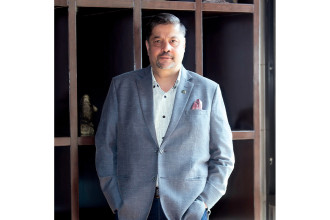
With the Coronavirus pandemic increasing its spread in Nepal, thousands of individuals are compelled to take crucial Covid 19 tests every day. These tests are the primary instrument for frontline workers to diagnose and trace Coronavirus patients. Months after the virus first hit Nepali soil, Polymerase Chain Reaction (PCR) Testing Centers have expanded from a single hospital in the capital to over 50 locations across the country, 26 of which are located in the Bagmati province itself. Based in Thapathali, Intrepid Diagnostic Center has established itself as one of the forerunners in handling molecular diagnosis and Coronavirus testing in the country. Here, the Director of Business Development and the person coordinating all the Covid 19 testing at the Intrepid Lab, Sambhavit Narayan Shrestha talks about the complex science and the even more intricate logistics that goes behind conducting these tests amidst rising public suspicion an confusion of PCR test results in the country. Excerpts from an interview with B360’s Sajeet M. Rajbhandari:
What is a PCR test? From the moment a swab is taken to when the results are published, what sort of process goes behind the scenes?
Molecular diagnosis is not only related to Covid 19 testing, it has a wide range of applications where you can use it to diagnose other diseases such as HPV, HIV and Tuberculosis. In the PCR tests, normally you take swabs from your oral and nasal cavities. These samples are then taken in a VTM (Viral Transport Medium) where it is stored and sent to the lab to be processed. Here the RNA extraction is done through the swabs which is then processed and sent for PCR testing. By using a SARS CoV-2 reagent, the test will determine whether it is a positive case or a negative case. Basically the RNA from the sample is amplified and the viral load is counted which then tells us if the result is positive or negative.
How does the PCR test differentiate from other forms of Covid 19 tests such as RDT?
These are very different methods. RDT is a more rapid approach where through a blood sample, you find out your results immediately. RDT tests the antibodies in your body that form after you have been infected. However it is not very accurate and is normally done for mass testing and when you want to find out something like ‘out of a thousand people what percentage is positive or negative’. But the PCR tests are a gold standard testing method which is believed to be 70%-80% accurate. Right now, this is the only gold standard test available for the SARS CoV-2 virus.
How much variation can be found within PCR tests? Are there differences in terms of processes, equipment and cost?
While the equipment might be different from place to place, the process is always the same everywhere. Just like how there are different pricings for things like cars, clothes or food, even for testing there are a lot of different price points. There are a lot of cheap Chinese brands present for the reagents that compete alongside better brands from Europe, America and Korea. While prices vary between cheap Chinese kits and kits from good brands, there are some approval methods which we look for. Normally all the kits must be listed for emergency with the WHO, this listing usually determines the reliability of the kits. US FDA approved kits are considered very good but tend to be more expensive and most of the kits we see being used in most labs tend to be Chinese kits. As for Intrepid Nepal, we have only used Korean FDA approved kits which are more reliable for results. The price for a test kit starts from $2-$3 and goes up to $15-$16 depending on the quality. But it is not just about the SARS CoV-2 kit, you also need to buy an RNA extraction kit which will cost around $2 with better kits costing $4-$5.
There have been many reports of patients receiving two different results. What factors might influence such outcomes?
There are a lot of factors that can affect the whole testing process. The quality of the kit may also makes a difference. Another factor that might make a difference is how test centers use their labs and how often they disinfect and fumigate it. If there is a cross contamination between the samples then the results will vary. Here at Intrepid Nepal, we do not conduct more than 300-400 tests per day; it is our limit. However some of the labs in Nepal have had to conduct more than 2,000 tests in a single day. Due to this, these labs may not have enough time to fumigate their labs which in turn increases the chances of cross contamination since you have been using the testing machines day and night. Another reason why there might be a difference in results may be because of the timings in which the samples are taken. If you are in an exit level for Covid 19, today’s result may vary from tomorrow’s result. You really need to compare apples to apples; unless you test completely identical samples then it is very unlikely that the results will be the same.

What kind of process have you had to go through in order to bring in PCR tests?
There haven’t been a lot of regular flights during the pandemic. Moreover, Covid 19 testing kits need to be brought in a special temperature condition. The kits must be stored at -20°C during the shipping process. So getting these goods from abroad is quite a challenge for now. You need to manage the dates for flights or even charter flights from Singapore, Korea or China. Due to these conditions we have to plan ahead and accurately order the goods because if you miss a day and the goods stay in transit for a day longer that would mean that all your kits are gone. Most airlines and airports lack cold-room facility which is essential for storing these kits. Right now, flights coming into the country are a bit more relaxed, so we have a few more options now, but during the initial lockdown period, we were forced to rely on cargo companies that chartered flights into the country by paying them a very steep freight cost.
Is there a possibility of manufacturing and distributing PCR test kits domestically?
Currently there are some local vendors that have been supplying test kits from China, Korea and even Europe. These kits are now being imported because right now this is a great business opportunity to sell them as the consumption numbers have been going up. However, manufacturing these kits from ground up will be quite difficult with the facilities available here. Right now, only the VTM is being produced here. The only Nepali brand VTM being produced is from Everest Parenteral for which we facilitated them with the formula to produce the VTM. We are also running the quality tests for their VTM in our lab, and it is one of the better VTMs available in the market, especially in comparison to most Chinese VTMs.
The government recently reduced the price for PCR testing from Rs. 4400 to Rs. 2000. How does this affect private test centers?
When it first started, the testing price was Rs. 5500, then in a very short period they reduced it to Rs. 4400 and now they have reduced it to Rs. 2000. This price is not at all viable for us because even though the price for testing kits has gone down, it hasn’t been as drastic as the government’s stated price. All private labs have submitted a costing sheet that states that the per test cost is around Rs. 3000 plus. Considering this price and other costs such depreciation, staff cost and whatever else that may occur during the test, Rs. 2000 in our view is not justifiable at all. It seems that the government hasn’t done their homework while determining the price. During such pandemic times, we cannot just look into the cost factor and stop our testing facility, we also need to be there for the people. If there was a greater quantity of test kits then it could justify the price, but for now Rs. 2000 isn’t close enough. The price should be something that is enough for labs to at least cover the cost for testing. Even if private labs could be assisted by the government with duty free facilities and cheaper taxation on the reagents then we might also be able to help the government with lower PCR testing price. Right now, we need to pay a 5% tax of PCR kits and 13% VAT on its import, this leads to an almost 24% hike in the cost price. These charges have been waived for government labs along with them receiving various grants and aids.
How likely is the arrival of a vaccine to Nepal? And when it does, what kind of distributions systems do think should be put in place?
It is still unclear when or where the vaccine will come from. If the vaccine comes from a business organisation, then there will be a cost to it. And if it comes from foreign governmental aid such as the Russian or Chinese government helping us, you need to have a pilot project run beforehand. From my view, I don’t see the vaccine coming to Nepal very soon, unless there is some government agreement between two countries where the vaccines are produced. Commercially, I think it will take some time for the vaccine to come to Nepal because the demand is so high globally.






